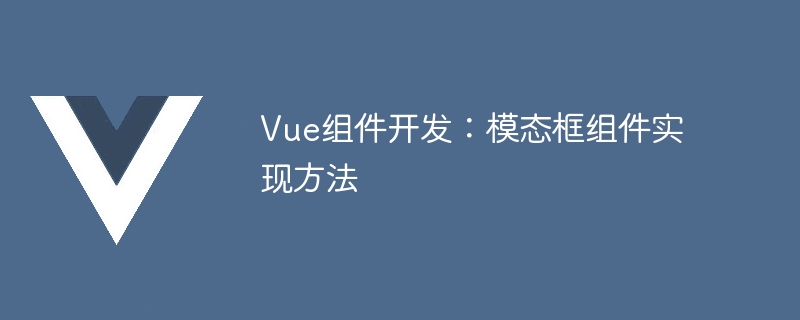Vue组件开发:模态框组件实现方法

Vue组件开发:模态框组件实现方法
在Web应用程序中,模态框是一种常见的UI控件,可以用于展示一些重要的内容,如提示信息、警告信息、提示用户进行某些操作等。本文将介绍如何使用Vue框架来开发一个简单的模态框组件,并提供代码示例以供参考。
- 组件结构
首先我们需要定义一个模态框组件,包括HTML结构、样式和逻辑功能。组件通常由一个父组件像子组件传递属性,子组件根据属性渲染UI。
下面是一个最简单的模态框HTML结构:
<template>
<div class="modal">
<div class="modal-content">
<!-- modal header -->
<div class="modal-header">
<h4 id="title">{{ title }}</h4>
<button class="close-btn" @click="closeModal">×</button>
</div>
<!-- modal body -->
<div class="modal-body">
<slot></slot>
</div>
</div>
</div>
</template>其中,模态框分为以下区域:
- 标题区(modal header),包括一个标题和一个关闭按钮。
- 主体区(modal body),用来显示模态框中需要展示的内容,可以通过插槽(slot)来传递内容。
我们还需要定义一些基本的样式,以使模态框看起来更漂亮。这里只提供一个简单的样式,读者可以根据自己的需要定义更复杂的样式。
.modal {
position: fixed;
z-index: 1;
left: 0;
top: 0;
width: 100%;
height: 100%;
overflow: auto;
background-color: rgba(0,0,0,0.4);
display: flex;
justify-content: center;
align-items: center;
}
.modal-content {
background-color: #fefefe;
border-radius: 5px;
box-shadow: 0 0 20px rgba(0,0,0,0.4);
max-width: 600px;
width: 70%;
padding: 20px;
}
.modal-header {
display: flex;
justify-content: space-between;
align-items: center;
}
.close-btn {
font-size: 24px;
font-weight: bold;
color: #aaaaaa;
}- 组件功能
现在,我们需要给模态框组件一些功能。首先,我们需要定义一些属性来传递模态框的标题和显示/隐藏状态。通过这些属性,我们可以在父组件中控制模态框的显示和隐藏。
export default {
name: 'Modal',
props: {
title: {
type: String,
default: ''
},
show: {
type: Boolean,
default: false
}
},
methods: {
closeModal() {
this.$emit('close');
}
}
}这里我们定义了两个属性:
- title:模态框的标题。
- show:模态框的显示/隐藏状态。
另外,我们在组件中定义了一个closeModal方法,用于关闭模态框。这个方法会在用户点击关闭按钮时被调用,并通过事件派发机制向父组件发送close事件,以告诉父组件模态框需要关闭。
接下来,我们需要在模态框组件的template中添加一些逻辑,根据show属性的值来显示或隐藏模态框。
<template>
<div v-if="show" class="modal">
<div class="modal-content">
<!-- modal header -->
<div class="modal-header">
<h4 id="title">{{ title }}</h4>
<button class="close-btn" @click="closeModal">×</button>
</div>
<!-- modal body -->
<div class="modal-body">
<slot></slot>
</div>
</div>
</div>
</template>- 使用组件
现在我们已经完成了模态框组件的开发。如果想要使用这个组件,只需要在父组件中引入组件,并传入需要的属性即可。
<template>
<div>
<button @click="showModal">显示模态框</button>
<Modal :title="title" :show="show" @close="closeModal">
<p>这里是模态框中的内容</p>
</Modal>
</div>
</template>
<script>
import Modal from './Modal.vue';
export default {
name: 'App',
components: {
Modal
},
data() {
return {
title: '这里是模态框标题',
show: false
};
},
methods: {
showModal() {
this.show = true;
},
closeModal() {
this.show = false;
}
}
}
</script>这里,我们在父组件中使用Modal组件,并传入了title和show属性。show属性控制模态框的显示和隐藏状态,title属性控制模态框的标题。
点击“显示模态框”按钮后,模态框会显示出来。点击关闭按钮,模态框会隐藏。
- 总结
通过本文的介绍,我们了解了如何使用Vue框架来开发一个简单的模态框组件。组件可以让我们把代码逻辑组织在一起,使其更易于理解和管理。当我们需要重复使用某个功能时,可以把这个功能抽象成一个组件,然后在需要的地方进行引用。这样可以提高代码的复用性和可维护性。
完整代码如下:
Modal.vue
<template>
<div v-if="show" class="modal">
<div class="modal-content">
<!-- modal header -->
<div class="modal-header">
<h4 id="title">{{ title }}</h4>
<button class="close-btn" @click="closeModal">×</button>
</div>
<!-- modal body -->
<div class="modal-body">
<slot></slot>
</div>
</div>
</div>
</template>
<script>
export default {
name: 'Modal',
props: {
title: {
type: String,
default: ''
},
show: {
type: Boolean,
default: false
}
},
methods: {
closeModal() {
this.$emit('close');
}
}
}
</script>
App.vue
<template>
<div>
<button @click="showModal">显示模态框</button>
<Modal :title="title" :show="show" @close="closeModal">
<p>这里是模态框中的内容</p>
</Modal>
</div>
</template>
<script>
import Modal from './Modal.vue';
export default {
name: 'App',
components: {
Modal
},
data() {
return {
title: '这里是模态框标题',
show: false
};
},
methods: {
showModal() {
this.show = true;
},
closeModal() {
this.show = false;
}
}
}
</script>以上是Vue组件开发:模态框组件实现方法的详细内容。更多信息请关注PHP中文网其他相关文章!

热AI工具

Undresser.AI Undress
人工智能驱动的应用程序,用于创建逼真的裸体照片

AI Clothes Remover
用于从照片中去除衣服的在线人工智能工具。

Undress AI Tool
免费脱衣服图片

Clothoff.io
AI脱衣机

Video Face Swap
使用我们完全免费的人工智能换脸工具轻松在任何视频中换脸!

热门文章

热工具

记事本++7.3.1
好用且免费的代码编辑器

SublimeText3汉化版
中文版,非常好用

禅工作室 13.0.1
功能强大的PHP集成开发环境

Dreamweaver CS6
视觉化网页开发工具

SublimeText3 Mac版
神级代码编辑软件(SublimeText3)
 vue中怎么用bootstrap
Apr 07, 2025 pm 11:33 PM
vue中怎么用bootstrap
Apr 07, 2025 pm 11:33 PM
在 Vue.js 中使用 Bootstrap 分为五个步骤:安装 Bootstrap。在 main.js 中导入 Bootstrap。直接在模板中使用 Bootstrap 组件。可选:自定义样式。可选:使用插件。
 vue怎么给按钮添加函数
Apr 08, 2025 am 08:51 AM
vue怎么给按钮添加函数
Apr 08, 2025 am 08:51 AM
可以通过以下步骤为 Vue 按钮添加函数:将 HTML 模板中的按钮绑定到一个方法。在 Vue 实例中定义该方法并编写函数逻辑。
 vue中的watch怎么用
Apr 07, 2025 pm 11:36 PM
vue中的watch怎么用
Apr 07, 2025 pm 11:36 PM
Vue.js 中的 watch 选项允许开发者监听特定数据的变化。当数据发生变化时,watch 会触发一个回调函数,用于执行更新视图或其他任务。其配置选项包括 immediate,用于指定是否立即执行回调,以及 deep,用于指定是否递归监听对象或数组的更改。
 vue返回上一页的方法
Apr 07, 2025 pm 11:30 PM
vue返回上一页的方法
Apr 07, 2025 pm 11:30 PM
Vue.js 返回上一页有四种方法:$router.go(-1)$router.back()使用 <router-link to="/"> 组件window.history.back(),方法选择取决于场景。
 vue多页面开发是啥意思
Apr 07, 2025 pm 11:57 PM
vue多页面开发是啥意思
Apr 07, 2025 pm 11:57 PM
Vue 多页面开发是一种使用 Vue.js 框架构建应用程序的方法,其中应用程序被划分为独立的页面:代码维护性:将应用程序拆分为多个页面可以使代码更易于管理和维护。模块化:每个页面都可以作为独立的模块,便于重用和替换。路由简单:页面之间的导航可以通过简单的路由配置来管理。SEO 优化:每个页面都有自己的 URL,这有助于搜索引擎优化。
 React与Vue:Netflix使用哪个框架?
Apr 14, 2025 am 12:19 AM
React与Vue:Netflix使用哪个框架?
Apr 14, 2025 am 12:19 AM
NetflixusesAcustomFrameworkcalled“ Gibbon” BuiltonReact,notReactorVueDirectly.1)TeamExperience:selectBasedAsedonFamiliarity.2)ProjectComplexity:vueforsimplerprojects,vueforsimplerprojects,reactforforforecomplexones.3)cocatizationNeedsneeds:reactofficatizationneedneeds:reactofferizationneedneedneedneeds:reactoffersizatization needeffersefersmoreflexiblesimore.4)ecosyaka
 vue遍历怎么用
Apr 07, 2025 pm 11:48 PM
vue遍历怎么用
Apr 07, 2025 pm 11:48 PM
Vue.js 遍历数组和对象有三种常见方法:v-for 指令用于遍历每个元素并渲染模板;v-bind 指令可与 v-for 一起使用,为每个元素动态设置属性值;.map 方法可将数组元素转换为新数组。
 vue.js怎么引用js文件
Apr 07, 2025 pm 11:27 PM
vue.js怎么引用js文件
Apr 07, 2025 pm 11:27 PM
在 Vue.js 中引用 JS 文件的方法有三种:直接使用 <script> 标签指定路径;利用 mounted() 生命周期钩子动态导入;通过 Vuex 状态管理库进行导入。






